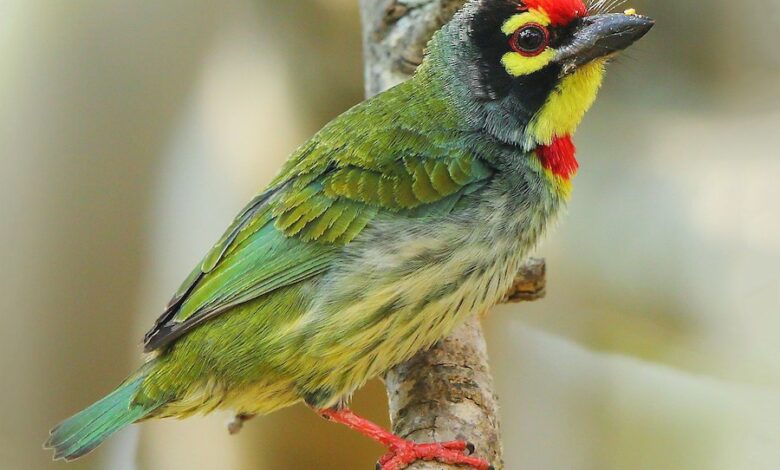
Coppersmith Barbet: The Pokpok Bird of the Philippines
The Philippines is home to an impressive array of bird species, each contributing to the country’s rich biodiversity. Among these is the Coppersmith Barbet (Psilopogon haemacephalus), affectionately nicknamed the “pokpok bird” by locals due to its signature metallic, tapping call resembling the sound of a coppersmith at work.
A Closer Look at the Coppersmith Barbet
The Coppersmith Barbet is a small, colorful bird that is unmistakable for its vibrant plumage and distinct sound. Its body is predominantly green, with a bright red patch on its forehead and throat, yellow markings around its neck, and a streaked underside. Its stout, curved beak is well-adapted for eating fruits and drilling into tree trunks to create nesting holes.
This bird is a year-round resident in the Philippines and can also be found in other parts of South and Southeast Asia. Its ability to adapt to both forested and urban environments makes it a common sight in gardens, parks, and even cities, where fruiting trees are abundant.
The ‘Pokpok’ Call
The Coppersmith Barbet is named for its repetitive call, which sounds like a rhythmic “pok-pok-pok,” reminiscent of a hammer striking metal. This call is most often heard during the day, especially in the mornings, as the bird defends its territory or attracts a mate. The sound is so consistent that many consider it the natural metronome of the Philippine countryside and urban greenspaces.
Behavior and Diet
These barbet birds are primarily frugivores, feeding on fruits such as figs, berries, and guavas. However, they are also known to occasionally eat insects, particularly during the breeding season, to meet the protein demands of their growing chicks.
Their feeding habits play a crucial role in the ecosystem as they help disperse seeds, contributing to forest regeneration. Coppersmith Barbets are cavity nesters, often excavating small holes in dead wood or soft tree trunks to lay their eggs.
Cultural Significance
The ‘pokpok’ bird is not just a delightful sight and sound in Philippine backyards; it is also woven into local lore and traditions. For many Filipinos, its call is associated with the arrival of sunny days or a reminder of simpler, rural life.
Additionally, the bird’s industrious tapping serves as a symbol of perseverance, reflecting the hardworking nature of the Filipino people.
READ: Cloud Rats Look Like Tiny Pandas
Conservation and Urban Coexistence
Despite being common and widespread, the Coppersmith Barbet faces threats from habitat loss and urbanization. Fortunately, its adaptability has allowed it to thrive in cities and towns, provided there are trees for food and nesting.Gardeners and nature enthusiasts can support these birds by planting native fruiting trees and preserving old or deadwood, which provides essential nesting sites. Awareness campaigns and conservation efforts in urban and rural areas alike can ensure that this bird continues to thrive alongside human development.
Where to Spot the Coppersmith Barbet
If you want to observe the ‘pokpok’ bird in its natural habitat, look for areas with abundant fruiting trees. Some of the best places include urban parks like Ninoy Aquino Parks and Wildlife Center in Quezon City or protected reserves such as the Subic Bay Forest Reserve. Even in bustling cities, their vibrant colors and distinctive calls can make them easy to spot.
The Coppersmith Barbet, or the ‘pokpok’ bird, is a vibrant symbol of the Philippines’ avian diversity and ecological wealth. Its rhythmic call not only adds music to the natural soundscape but also reminds us of the beauty and resilience of nature.
Whether you’re a seasoned birdwatcher or a curious observer, the ‘pokpok’ bird is sure to capture your attention and inspire a deeper appreciation for the feathered inhabitants of the Philippines. So next time you hear its distinctive “pok-pok-pok,” take a moment to admire this remarkable little creature.
